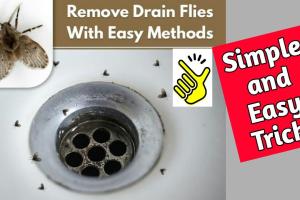Ultimate Guide on How to Get Rid of Drain Flies: Effective Solutions & Prevention

-
Quick Links:
- Understanding Drain Flies
- Identifying Drain Flies
- Understanding the Life Cycle
- Causes of Drain Fly Infestations
- Step-by-Step Guide to Get Rid of Drain Flies
- Home Remedies for Drain Flies
- Chemical Solutions for Drain Flies
- Prevention Tips
- Case Studies and Expert Insights
- FAQs
Understanding Drain Flies
Drain flies, also known as moth flies, are small, flying insects that often swarm around sinks, drains, and bathrooms. They are often mistaken for fruit flies but can be distinguished by their moth-like appearance and fuzzy bodies. Understanding their behavior and habitat is key to effectively dealing with an infestation.
Identifying Drain Flies
Drain flies are typically 1/16 to 1/8 inch long with a characteristic fuzzy body and broad wings. They are usually gray or black in color. Here are some tips to help you identify them:
- Look for them near sinks, bathtubs, and drains.
- Check for small clusters of flies hovering around wet areas.
- Inspect for larvae in standing water or damp organic matter.
Understanding the Life Cycle
Drain flies undergo a complete metamorphosis that includes four stages: egg, larva, pupa, and adult. Here’s a brief overview of each stage:
- Egg: Females lay eggs in moist environments, often in sludge or organic material found in drains.
- Larva: After a few days, the eggs hatch into larvae, which feed on organic matter.
- Pupa: The larvae then pupate for a few days before emerging as adults.
- Adult: Adult drain flies can live for several weeks and reproduce quickly.
Causes of Drain Fly Infestations
Understanding what attracts drain flies is crucial in preventing infestations. Common causes include:
- Standing Water: Any stagnant water can serve as a breeding ground.
- Organic Matter: Leftover food, hair, and soap scum can attract these flies.
- Poor Drainage: Clogs and slow-draining sinks can create an environment conducive to breeding.
Step-by-Step Guide to Get Rid of Drain Flies
To effectively eliminate drain flies, follow these steps:
- Identify the Source: Inspect all drains and standing water sources.
- Clean Drains: Use a mixture of baking soda and vinegar to clean drains thoroughly.
- Remove Breeding Sites: Ensure there are no food residues or organic matter.
- Set Traps: Create traps using apple cider vinegar or store-bought solutions.
- Monitor: Keep an eye on the traps and the number of flies.
- Call Professionals: If the infestation persists, consider hiring pest control experts.
Home Remedies for Drain Flies
There are several effective home remedies you can use to combat drain flies:
- Baking Soda and Vinegar: Pour a cup of baking soda followed by a cup of vinegar down your drains. This will help clean out any organic matter.
- Apple Cider Vinegar Trap: Fill a bowl with apple cider vinegar and cover it with plastic wrap. Poke small holes in the wrap to trap the flies.
- Essential Oils: Use essential oils like peppermint or eucalyptus in a diffuser to deter flies.
Chemical Solutions for Drain Flies
If home remedies do not work, consider using chemical solutions:
- Drain Cleaners: Use a commercial drain cleaner to eliminate organic material.
- Insecticides: Apply insecticides specifically designed for flying insects.
- Professional Pest Control: For severe infestations, hire professionals who can use more potent solutions safely.
Prevention Tips
Preventing drain flies is easier than eliminating them. Here are some tips to keep them at bay:
- Regularly clean drains and eliminate organic matter.
- Fix any plumbing issues that cause standing water.
- Cover food and clean up spills promptly.
- Use drain covers to prevent flies from entering.
Case Studies and Expert Insights
In a study conducted by the University of Florida, researchers found that drain fly infestations commonly occur in homes with poor drainage systems. Similarly, pest control expert Dr. Ben Thomas notes that regular maintenance and cleaning can significantly reduce the likelihood of infestations.
FAQs
1. What attracts drain flies?
Drain flies are attracted to moist areas, organic matter, and stagnant water.
2. How can I tell if I have a drain fly infestation?
Look for small, fuzzy flies near drains and inspect for larvae in organic material.
3. Can drain flies harm me or my pets?
No, drain flies are not harmful; they do not bite or sting.
4. How long do drain flies live?
Adult drain flies typically live for about 2 weeks.
5. Are there any natural predators of drain flies?
While there are no specific predators, maintaining a clean environment can deter them.
6. Can I use bleach to get rid of drain flies?
Using bleach is not recommended as it can harm your plumbing and is not effective against larvae.
7. How often should I clean my drains?
Regular cleaning every month can help prevent drain fly infestations.
8. What should I do if home remedies don’t work?
If home remedies fail, consider using chemical solutions or contacting a pest control professional.
9. Can I prevent drain flies in the winter?
Yes, drain flies can still breed in winter. Ensure that drains are clean and dry.
10. Are drain flies seasonal?
Drain flies can be present year-round but are more noticeable in warmer months.